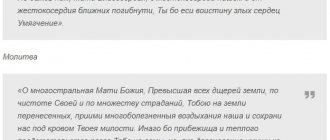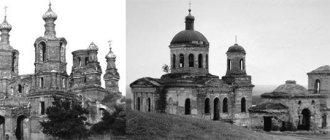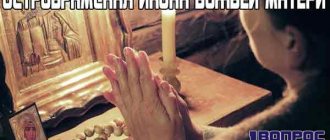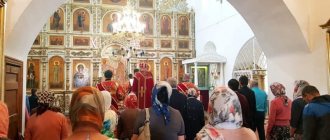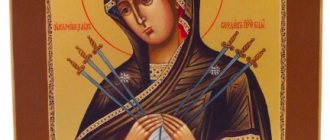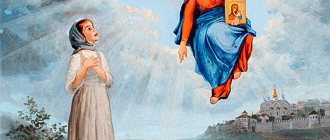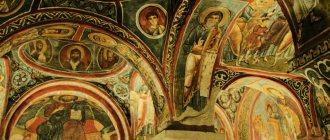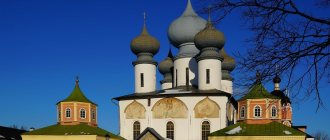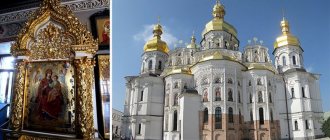The Jerusalem Icon of the Mother of God is one of the most revered images of the Mother of God. This image is very ancient and has an interesting history of origin. The relic became famous for many miracles performed through prayers to it. Today, the Jerusalem Icon continues to amaze believers with its incredible power. The celebration of the great Christian shrine falls on October 25th. With the advent of this date, solemn services and religious processions are held in all Orthodox churches.
Author of the holy image
“How can someone paint an icon who not only does not have before him, but has never seen the prototype, or, to put it in the language of painting, nature?” - asked P.A. Florensky, emphasizing that real icon painting is a reflection of the icon painter’s personal experience, his meeting with God.
From this point of view, the experience of the creator of the Jerusalem Icon of the Blessed Virgin Mary is unique.
The Apostle Luke personally knew the Most Holy One - this is evidenced, for example, by the fact that the Gospel of Luke contains many details of Her life that are not known from other evangelists. Therefore, the iconographic images of the Mother of God created by him are also valuable, because they captured Her appearance during her earthly life
We do not know the circumstances of the appearance of the image. Tradition, coming from the first centuries of the history of the Church, has preserved only the place where the icon was painted - Gethsemane, and the year of its creation - the 48th after the Nativity of Christ. 15 years have passed since the Ascension of the Lord.
What do they pray to the shrine for?
Prayers in front of the Jerusalem icon help in any life situations. Through this great shrine, people suffering from various diseases, as well as those who want to help loved ones with health problems, turn to the Mother of God. Couples who cannot become parents come to the icon and ask for healing from infertility. Parents pray to this image to admonish their children, to protect their children from the negative influence of evil people, to guide them on the true path.
Other requests are also made to the Mother of God depicted in the religious painting:
- about maintaining mutual understanding in the family;
- resolving conflicts and misunderstandings;
- getting rid of despondency and mental anguish;
- support in the fight against temptations;
- strengthening faith in the Lord.
It is believed that prayers said at the icon can stop dangerous epidemics, relieve extreme poverty, save from persecution and injustice. Military men who defend their homeland, as well as their relatives who want to wait for their loved ones safe and sound, have long prayed before the Jerusalem icon.
A sincere, pure prayer to the Mother of God always remains heard and receives an answer. One should turn to the Most Pure Virgin with deep faith, without any evil in the heart. When talking with the Ever-Virgin, you can read sacred texts from the prayer book or speak in your own words, coming from the soul.
In the Holy City
The first location of the image was obviously Jerusalem. But where the image was during the first three centuries of the history of the Church, during the persecution, is not known exactly. It is assumed that its location was the Christian communities of the Roman province of Antioch. The location of the shrine is clearer from the 4th century, when the persecution of Christians ceased, and Jerusalem was restored after its destruction by the Romans in 70.
Useful materials
In the 330s, under Emperor Constantine, many Christian relics were found in the Holy City: the Cross of the Lord, the Crown of Thorns of the Savior, the site of the Crucifixion of the Savior and the Holy Sepulcher were found. In the place where events took place that determined the entire course of world history, the Church of the Resurrection of Christ appeared in 335. Its foundation and construction were the work of the emperor’s mother, Queen Helena. Many Christian shrines are moved here. It is believed that this is how the image by St. Luke.
Humble Mary
One of the most famous miracles during these years was the conversion of St. Mary of Egypt. Mary, who led a life far from Christian, came to worship the Cross of the Lord. But time after time, an unknown force did not allow her to enter the temple. It was then that the sinner cried out in repentance to the Mother of God, whose icon was at the entrance. The Most Pure One not only accepted Mary’s repentance, but also became her leader on her further monastic path. Many believe that this icon was the Jerusalem icon.
In the capital of Byzantium
Time passed. In the east of the Roman Empire, a new capital arose - the city of Constantinople, then the Byzantine Empire was formed. Unlike Rome, which had a pagan past, “New Rome” was built as a Christian city. Christian relics began to be collected here from the time of Constantine the Great. It is known that in 463, King Leo the Great gave his capital the miraculous Jerusalem image of the Mother of God. This emperor especially revered the Blessed Virgin: after all, according to the surviving legend, She Herself blessed Leo to reign when he was still a simple warrior. At first, the shrine was in a temple called “The Source”, at the site of the appearance of the Mother of God to the future emperor. Then the location of the icon became the Church of the Mother of God in Blachernae.
Miracle at the siege of Constantinople
At the beginning of the 7th century. a miraculous sign was recorded again. Then the Byzantine Empire was constantly faced with barbarian tribes that appeared on its northern borders. In 626, Constantinople was besieged by tribes that the Byzantine historian defines as “Scythians.” It is mentioned that, in addition to the Scythians, warriors from different tribes took part in the siege, among them were Slavs. The number of attackers was huge, the forces of the defenders of the city were small. With their last hope, people rushed to the churches. There were many worshipers in the Blachernae Church.
7
August
626
After a ten-day siege, the 80,000-strong army began the decisive assault on the capital of Byzantium.
A huge number of barbarians moved towards the city from sea and land. But the assault not only failed: a horrific defeat awaited the enemies. Under the city walls, the number of those killed was such that the pagans were unable to bury everyone. And something strange happened at sea. The attacking ships attacked the Byzantine ships. They began a hasty retreat. But suddenly the barbarian fleet was scattered and sunk, and this happened near the Blachernae Temple - the location of the miraculous icon.
The Byzantine historian Sincellus writes: “Some say that our soldiers were moved to retreat not by fear of the enemy, but that the Virgin herself, wanting to show her power to work miracles, ordered them to feign retreat so that the barbarians would suffer complete collapse near Her holy temple, our saving grace. pier and quiet harbor - the Blachernae Church of the Virgin Mary.”
It is also worthy of attention that among the besiegers there were Slavs. Was it not then that they first realized the almighty power of the Christian God? A little more than 350 years will pass and the miraculous image will travel to Rus'.
A little background
The history of the burning icon of the Mother of God is closely connected with the text from the Old Testament concerning the life and deeds of the prophet Moses.
“The Burning Bush” is the most popular icon against fire in the house. But if you take a closer look at its history, a much deeper meaning and meaning of this image is revealed.
Moses was born in Egyptian lands around the 8th century BC. The Jewish population of Egypt then increased greatly, and the pharaoh, concerned about this, ordered all adult Israelis to be enslaved, and newborn boys to simply be killed.
Moses' mother did not wish such a sad fate for her own son. She first hid the newborn, and then put him in a basket and sent him down the Nile. And it had to happen that he was found by an Egyptian princess who had mercy on the baby!
Ironically, they decided to give Moses to a Jewish family, and it turned out that his own mother became his wet nurse. But he grew up at the court of Pharaoh, surrounded by honors and wealth, like a well-born Egyptian.
But one day Moses saw something terrible: the overseer was mercilessly mocking the working Jews. He became angry, killed the overseer and was forced to flee.
The Jewish husband wandered in the desert for a long time until a priest took him in. Moses began to lead the life of a simple person, got used to physical labor and even married one of the daughters of his savior.
One day the future prophet was tending sheep. Suddenly he saw a burning thorn bush (that is, a “bush”) on Mount Sinai and wanted to approach it, because the bush was burning, but it did not burn up. The miracles did not end there: the Voice of God came from the bush, ordering Moses to take off his shoes, for he intended to approach the shrine. The Lord also commanded the prophet to lead the Jews from Egypt to the Promised Land and endowed him with the ability to perform miracles according to God’s will.
Horace William Petherick. Exodus
According to the Old Testament, Moses led the Jews through the desert for 40 long years. The people of Israel nevertheless reached it, but the prophet died a little short of reaching the goal. According to biblical texts, he lived for 120 years!
Over time, the image of the burning bush became associated with the Mother of God. Just as a bush does not burn in a raging flame, so the Ever-Virgin is eternally pure and immaculate.
Jerusalem icon in Rus'
In 988, in Korsun, a Greek colony on the Black Sea coast, the Grand Duke of Rus', Vladimir, received Holy Baptism. His path to Christ was not easy: there were doubts and difficult personal choices. A pagan, a warrior prince, a favorite of the squad, he did not easily perceive Christian truths. But as a sign of God’s help, he received an expensive gift from Constantinople - the Jerusalem image of the Mother of God. Apparently, the icon was brought to him by his intended bride, the Byzantine princess Anna. Going to Rus', she took the image with her to bless both herself and the Russian land.
Perhaps one of the first miracles of the Jerusalem icon in Rus' was the transfiguration of its Grand Duke. From a pagan he became a Christian of deep and strong faith. One of the first things Vladimir did upon arriving home from Korsun was to send the Jerusalem Icon to Novgorod. Novgorodians have always opposed Kyiv in the political struggle in Rus'. It was to them, his opponents, that the prince sent a shrine that was so dear to him - as a blessing and reconciliation in Christ.
Since then, the Jerusalem image was in the Cathedral of St. Sophia of the Wisdom of God in Novgorod, and the northern regions of Rus' especially loved this particular icon. The image was in Sofia Novgorod for four centuries.
Hagia Sophia in Novgorod was built in 1045-1050. by order of the Novgorod prince Vladimir.
Interesting fact
In 1478 Novgorod became part of Muscovite Rus'. But even when taking away the veche bell - a symbol of independence - from the former Novgorod Republic, “Sovereign of All Rus'” Ivan III did not touch the main Novgorod shrine, donated by Vladimir.
But the veneration of the image by the Novgorodians did not stop Ivan IV the Terrible. After the notorious campaign of 1571, the king took the shrine to the capital. In the Kremlin, in the Assumption Cathedral, he installed it in a place of honor, among other shrines. However, the tsar did not take away the beautiful and rich salary from Novgorod, once made by the pious townspeople. Subsequently, the Novgorodians made an exact copy of the image. Now in the St. Sophia Cathedral, under an expensive cover, there was a list of shrines.
War of 1812 and disappearance of the image
When Moscow was captured by the French Emperor Napoleon in 1812, his troops plundered the Russian capital. The famous fire completed the matter. Then many temples were destroyed, shrines and relics were lost. The Jerusalem icon also disappeared from the cathedral plundered by the French. As contemporaries testified, the image was taken to France. He was sent to the famous Notre Dame, Notre Dame Cathedral.
Distinctive features
The icon is similar in its iconography to the Georgian image, and many icons are painted in its likeness: Iverskaya, Kazan, Sporuchnitsa sinners. The Mother of God is shown in a half-length image, with her right hand She supports the Son, Her head is bowed. The Divine Infant's face is turned to Mother, he holds a scroll in his left hand, and his right hand is raised in a blessing gesture.
The Son's face turned towards the Mother means all-encompassing love and attention to Her. The icon shows a silent dialogue, the unity of God and man.
Having completely absorbed human nature into Himself, Jesus remained God, one of the persons of the Holy Trinity. But the Queen of Heaven became a guide for the Son into the world of people. Her soul was pierced by many sharp swords on the day of the crucifixion of the Son, but the Mother walked her life’s path on earth with dignity.
Important! And if every person patiently and humbly goes through all the hardships, then at the end of his life a great reward will await him - eternity with Christ.
The Jerusalem image has several varieties:
- on the margins of the icon are depicted apostles, saints, martyrs, but they are not part of the composition, but simply float in the air to the left and right;
- Standing next to Mary are her parents—the righteous saints Joachim and Anna.
Where is the original icon now?
The fate of the original shrine is still unknown. For about a century it was believed that she was in Paris. However, attempts to find the image in Notre Dame were unsuccessful. According to the French authorities, the icon is not listed among the historical relics and shrines of the cathedral. In the 1970s attempts to find the image were made by L.A. Uspensky is a famous historian and theologian. However, his efforts did not bring results. The question of the location of the original by St. Luke remains open.
After disappearing from the Assumption Cathedral, the icon was replaced by a list, which can still be seen behind the so-called. The patriarchal place in the altar part of the temple.
Honored lists of images in Russia
In total, before 1917, about 40 copies of the icon were known, many of them were revered as miraculous. Some of them have survived to this day. The most famous copies of the image are:
- In the Assumption Cathedral in Moscow. This is a copy made in the 17th century. for the Church of the Nativity of the Virgin Mary at the royal palace. It replaced the original in 1812.
- In the Nativity Church of the capital's Izmailovo district, also a former royal residence. This copy is from the late 17th century.
- In the Intercession Church in Izmailovo. In 1866, the icon became famous for the miracle of ending the cholera epidemic that was raging in the surrounding villages. Then the custom of religious processions with the shrine appeared from Easter to October 12, the day of celebration of the icon. Since 1932, the cathedral has been closed, but the image has been preserved. After returning to the restored temple, another miraculous sign occurred: the renewal of the image.
There are also lists from the Jerusalem image in other cities of the country.
Troparion to the Most Holy Theotokos before the Icon of Her “Jerusalem”
voice 4 God-happy Lady,/ glorified Mother of Generosity and love for mankind,/ all-merciful Intercessor for the whole world!/ Thy servants diligently resort to Thy intercession,/ and to adversity We pray to your image with tenderness:/ create a warm prayer for your Son and our God,/ O All-Singing Queen Mother of God, / may He save us from all illnesses and sorrows for Your sake, / and free us from all sins, / He will show us heirs of His Heavenly Kingdom: / greatness is beyond words This is like Mother’s boldness to Him, / and ask everything from Him you can, // One blessed forever.
Kontakion to the Most Holy Theotokos before the Icon of Her “Jerusalem”
voice 5
Do not deny, O Merciful Mother, / our tears and sighs, / but having mercifully accepted our petitions, / before Your Jerusalem icon / strengthen the faith of praying people, / with the tenderness of their hearts fulfill,/ and help them carry the cross of earthly life,// You can do whatever you want. Prayer to the Most Holy Theotokos before Her “Jerusalem” icon. Most Holy Lady, Lady Theotokos, the hope of all who trust in You, Intercessor of the sad, refuge of the desperate, widows and orphans, Nourisher! Hear and have mercy on us, Thy sinful and unworthy servants, who fall with tenderness before Thy most pure image: beseech, O Merciful Lady, Thy Son and our Lord Jesus Christ , may His righteous anger turn away from us, may He forgive our sins and iniquities, for we are worthy By His goodness we may end our life in repentance and receive His mercy with all His elect, as blessed and glorified are you forever and ever. Amen.
Meaning and symbolism
The image of the Most Pure Virgin Mary is a priceless shrine, which a huge number of believers seek to venerate. Through the Face of Jerusalem, Orthodox Christians not only from Russia, but also from all over the world turn to the Queen of Heaven.
The icon symbolizes:
- the boundless love of the Mother of God for all humanity;
- great compassion and mercy;
- the desire to help everyone who converts with true faith;
- vigilant intercession for all people before the Almighty;
- spiritual purity, which every Christian should strive for.
The plot of the icon also speaks of the incredible power of the Ever-Virgin’s love for the Son of God, who is destined to give his own life to save the human race from sins.
